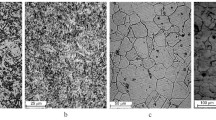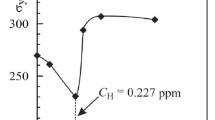Abstract
We study the influence of high-temperature aging of 15Kh2MFA steel in a hydrogen-containing medium on its threshold characteristics of cyclic crack resistance depending on the thickness of the specimens. The size effect of the threshold of cyclic crack resistance for a metal in the intact state or subjected to aging in an atmosphere of hydrogen followed by degassing is caused solely by the influence of crack closure. We show that hydrogen adsorbed by the metal ambiguously affects the effective threshold of cyclic crack resistance of the aged metal depending on the thickness of the specimens and the state of the metal.
Similar content being viewed by others
REFERENCES
J. C. Radon, “Fatigue crack growth in the threshold region,” in: Prelim. Proc. of the Symposium on Fatigue Thresholds (Stockholm, 1981), Vol. 1, Aeronautical Research Institute, Stockholm, Sweden (1981), pp. 4:1–4:22.
V. T. Troshchenko, V. V. Pokrovskii, V. G. Kaplunenko, et al., “Influence of the sizes of specimens on the crack resistance of heatresistant pressure-vessel steels,” Probl. Prochn., No. 10, 3–11 (1982).
S. Ya. Yarema, Test Method for the Determination of Crack Growth Rate and Crack Extension Resistance Under Cyclic Loading, Karpenko Physicomechanical Institute, Ukrainian Academy of Sciences, L'viv (1994).
O. M. Romaniv, A. N. Tkach, and Yu. N. Lenets, “Influence of the stressed state near the tip of a fatigue crack on its growth and closure in the subthreshold region,” Fiz.-Khim. Mekh. Mater., 21, No. 4, 44–50 (1985).
H. M. Nykyforchyn, A. A. Popov, B. N. Andrusiv, and Yu. V. Zima, “Influence of the size factor on the cyclic crack resistance of plastic steels under low-amplitude loads,” Fiz.-Khim. Mekh. Mater., 21, No. 4, 57–64 (1985).
O. M. Romaniv, H. M. Nykyforchyn, and L. Yu. Kozak, “Fatigue crack growth in structural steels under the influence of gaseous environments,” in: Proc. of the 7th European Conf. on Fracture, ECF-7, Vol. 2, EMAS (1988) pp. 1153–1155.
H. M. Nykyforchyn, O. Z. Student, and I. D. Skrypnyk, “Ambiguous influence of hydrogen on the growth of fatigue cracks in heatresistant steels,” Fiz.-Khim. Mekh. Mater., 30, No. 4, 7–15 (1994).
H. M. Nykyforchyn, O. Z. Student, B. P. Loniuk, and I. R. Dzioba, “Effect of aging of steam pipeline steel on its fatigue crack growth resistance,” in: F. Ellyin and J. W. Provan (editors), Proc. of the Eighth Internat. Conf. on the Mechanical Behavior of Materials, ICM8: Progress in Mechanical Behavior of Materials, Vol. 1: Fatigue and Fracture (Victoria, 1999), Fleming, Victoria (1999), pp. 398–403.
G. P. Karzov, V. P. Leonov, and B. T. Timofeev, High-Pressure Welded Vessels [in Russian], Mashinostroenie, Leningrad (1982).
O. E. Andreikiv and O. V. Gembara, “A method for the evaluation of the degree of damage to the walls of pressure vessels subjected to thermal cycling in hydrogen,” Mashinoznavstvo, No. 4, 18–22 (1999).
O. Z. Student and B. P. Lonyuk, “Growth of fatigue cracks in 15Kh2MFA steel held in high-temperature hydrogen,” Fiz.-Khim. Mekh. Mater., 33, No. 4, 121–126 (1997).
O. Z. Student and B. P. Lonyuk, “A procedure of accelerated high-temperature aging of steels,” Fiz.-Khim. Mekh. Mater., 33, No. 6, 111–112 (1997).
O. M. Romaniv, H. M. Nykyforchyn, and L. Yu. Kozak, “Cyclic crack resistance of structural steels in gaseous hydrogen,” Fiz.-Khim. Mekh. Mater., 22, No. 5, 3–15 (1986).
S. Suresh, G. F. Zamiski, and R. O. Ritchie, “Oxide-induced crack closure: an explanation for near threshold corrosion fatigue crack growth behavior,” Metal. Trans., 12A, No. 8, 1435–1443 (1981).
O. Z. Student, P. Cichosz, and J. Szymkowski, “Correlation between fracture roughness and fatigue threshold of high-temperature degraded steel,” Fiz.-Khim. Mekh. Mater., 35, No. 6, 37–42 (1999).
R. O. Ritchie and S. Suresh, “Some considerations on fatigue crack closure at near-threshold stress intensities due to fracture surface morphology,” Metal. Trans., 13A, No. 5, 937–940 (1982).
O. Z. Student, “Influence of hydrogen on the mechanical properties of the 15Kh2MFA reactor steel,” Mashynoznavstvo, No. 4, 23–29 (1999).
V. V. Panasyuk (editor), Fracture Mechanics and Strength of Materials. A Handbook, Vol. 1, V. V. Panasyuk, O. E. Andreikiv, and V. Z. Parton, Foundations of Fracture Mechanics [in Russian], Naukova Dumka, Kiev (1988).
Rights and permissions
About this article
Cite this article
Student, O.Z., Nykyforchyn, H.M., Lonyuk, B.P. et al. Specific Features of the Size Effect of the Thresholds of Cyclic Crack Resistance of 15Kh2MFA Steel under the Action of Hydrogen. Materials Science 36, 534–540 (2000). https://doi.org/10.1023/A:1011310021143
Issue Date:
DOI: https://doi.org/10.1023/A:1011310021143




